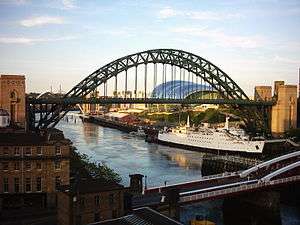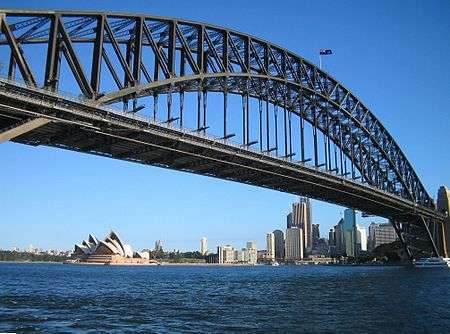Dorman Long
Dorman Long is an engineering consultancy and equipment manufacturer for the construction of long-span bridges, power stations, refineries, offshore structures, stadia and other large building structures. Originally based in Middlesbrough, northeast England, the company was a major steel producer later diversifying into bridge building. Dorman Long was once listed on the London Stock Exchange.
| Dorman Long | |
| Private | |
| Industry | Manufacturing |
| Predecessor | Losh, Wilson and Bell |
| Founded | 1875 |
| Headquarters | Northamptonshire, UK |
| Products |
|
| Owner |
|
| Website | www |
History
The company was founded by Arthur Dorman and Albert de Lande Long when they acquired West Marsh Iron Works in 1875.[2] In the 1920s Dorman Long took over the concerns of Bell Brothers and Bolckow and Vaughan and diversified into the construction of bridges.[3] In 1938 Ellis Hunter took over as Managing Director and he continued to lead the business until 1961.[4]

In 1967 Dorman Long was nationalised, along with 13 other British steel-making firms, becoming subsumed into the government-owned British Steel Corporation. In 1982 Redpath Dorman Long, the engineering part of the business, was acquired by Trafalgar House who in 1990 merged it into Cleveland Bridge & Engineering Company in Darlington.[5]
In 2000 there was a management buyout of Cleveland Bridge which led to the formation of Dorman Long Technology (DLT) in August 2000. DLT was formed as an amalgamation of the Cleveland Bridge engineering office with an outside construction consultant (Lowther-Rolton) and a heavy lift contractor (Zalcon), both of whom had been working closely with Cleveland Bridge throughout the 1990s. DLT is now an independent company, registered in the UK, carrying out bridge design and construction engineering together with design and supply of heavy lifting equipment for the construction of bridges, refineries, power stations, wind farms, offshore drilling rigs, large roofs and other large pre-assembled structures.[6]
Iron and steel
Iron-making has been known in Cleveland since the Romans found iron slags in North Yorkshire, with small-scale iron-making known to have taken place at Rievaulx and Whitby Abbeys and at Gisborough Priory in the 17th century.
Some of the key events connected with iron-making in Cleveland:
1837: The first Cleveland ironstone mine opens, at Grosmont, for the Losh, Wilson and Bell ironworks.
1841: Bolckow and Vaughan open the first ironworks in Middlesbrough.
1850: 8 June - The Discovery of the Cleveland Main Seam of Ironstone at Eston by Ironmaster John Vaughan and mining engineer John Marley both of Bolckow & Vaughan. The Cleveland iron rush begins.
1855: 30 blast furnaces operate within six miles (10 km) of Middlesbrough.
1865: One million tonnes per annum (TPA) of iron are produced to make the area one of the world's major centres of iron production.
1875: Number of blast furnaces increases to 100, producing two million TPA.
1879: Sidney Gilchrist Thomas arrives in Cleveland and introduces the first commercial steel.
1901: Partial amalgamation of Bell companies with Dorman Long.
1902: The first integrated steelworks, involving conversion of iron ore to finished rolled steel shapes, is built at Cargo Fleet.

1917: The Redcar steel plant is opened, making steel in the open hearth process.
1918: Cleveland Works opens.
1924: Dorman Long wins the contract to build the Sydney Harbour Bridge.
1928-9: Dorman Long takes over residues of Bell and Bolckow Vaughan, including North Skelton Mine.
1946: Dorman Long purchases 600 acres (2.4 km2) of land between the Redcar and Cleveland Works to build the Lackenby development.
1967: Dorman Long, South Durham Steel Iron Co, and Stewarts and Lloyds come together to create British Steel and Tube Ltd.
1967: The steel industry is nationalised and the British Steel Corporation is born.
1973: The existing Redcar Ironworks site development begins.
1979: The number of blast furnaces drops to one - producing 3.3 million tons per year.
1989: Company is privatised becoming British Steel plc.
1990: Merged with The Cleveland Bridge & Engineering Company, Darlington.
1999: British Steel plc merges with the Dutch steel and aluminium company Koninklijke Hoogovens to become Corus Group.
2000: Dorman Long Technology Ltd formed as an independent company as part of a management buy out of Cleveland Bridge in August 2000.
2015: Former Dorman Long Steel plant on Teesside ceased production after SSI mothballed the Redcar works following a global downturn in the price of steel and later announced its UK arm had gone into liquidation.[7]
Bridge building
The most famous bridge ever constructed by a Teesside company was Dorman Long's Sydney Harbour Bridge of 1932,[8] of similar construction to but, contrary to popular belief, not modelled on the 1928 Tyne Bridge, a construction regarded as the symbol of Tyneside's Geordie pride, but also a product of Dorman Long's Teesside workmanship. The greatest example of Dorman Long's work in Teesside itself is the single span Newport Lifting Bridge (a Grade II Listed Building). Opened by the Duke of York in February 1934 it was England's first vertical lift bridge.[9]
List of bridges constructed
The following is a list of some of the bridges built by the Dorman Long: it is not fully comprehensive.
| Bridge | Location | Year | Total length | Notes | Ref | |
|---|---|---|---|---|---|---|
| ft | m | |||||
| Omdurman Bridge | White Nile, Sudan | 1926 | 2,012 | 613 | 7 fixed spans, one swing span, 3,700 tons | [10] |
| Desouk Bridge | Lower Nile, Egypt | 1927 | 2,010 | 610 | 10 spans including 194 feet (59 m) swing span, 3,800 tons | [11] |
| Tyne Bridge | Newcastle, England | 1928 | 1,254 | 382 | Approximately 8,000 tons, (Road) | [12] |
| Alfred Beit Bridge | South Africa | 1929 | 1,515 | 462 | 1,876 tons | [13] |
| Sydney Harbour Bridge | Sydney, Australia | 1932 | 3,770 | 1,150 | Total weight of fabricated steelwork 51,000, weight of steel in the arch 38,000 tons | [8] |
| Grafton Bridge | Grafton, NSW, Australia | 1932 | 1,309 | 399 | It is a dual level road and rail Bascule Bridge, the upper deck carrying a roadway and the lower level carrying the rail line and foot bridge. | [14] |
| Lambeth Bridge | London, England | 1932 | 776 | 237 | 5 spans, 4,620 tons, (Road) | [15] |
| Memorial Bridge, Bangkok | Thailand | 1932 | 755 | 230 | 1,100 tons, (Road) | [16] |
| Khedive Ismail Bridge | Cairo, Egypt | 1933 | 1,250 | 380 | 3,000 tons | [17] |
| Newport bridge | Middlesbrough | 1934 | 270 | 82 | The central lifting span 66 feet (20 m) wide, weighing 5,400 long tons (5,500 t); the towers are 182 feet (55 m) high. The total weight is 8,000 tons. | [18] |
| Birchenough Bridge | Zimbabwe | 1935 | 1,242 tons. | [19] | ||
| Storstrøm Bridge | Denmark | 1937 | 10,535 | 3,211 | 21,000 tons, (Railway and Road) | [20] |
| Chien Tang River Bridge | China | 1937 | 3,480 | 1,060 | 16 equal spans, 4,135 tons, (Railway and Road) | [21] |
| Adomi Bridge (orginally Volta Bridge) | Atimpoku, Ghana | 1957 | 1,096 | 334 | arch bridge with roadway suspended from arch | [22] |
| Silver Jubilee Bridge | Runcorn and Widnes, England | 1961 | 1,582 | 482 | Road | [23] |
Dorman Museum
In 1904 Sir Arthur Dorman of Dorman Long gave the Dorman Museum to Middlesbrough in honour of his youngest son, George Lockwood Dorman, an avid collector who died in the Boer War. Amongst the museum's exhibits is a collection of ceramics from the local Linthorpe Pottery, which was known for its iridescent glazes which were, at the time, were not produced anywhere else in Europe.[24]
References
- "Companies House PSC Register". Retrieved 7 July 2020.
- "North East England History Pages". talktalk.net. Retrieved 22 October 2015.
- Tolliday, Steven (1987). Business, Banking, and Politics: The Case of British Steel, 1918-1939. Harvard University Press. pp. 47–48.
- "SCALE AND SCOPE". google.co.uk. Retrieved 22 October 2015.
- Cleveland Bridge history Archived 3 March 2009 at the Wayback Machine
- "Dorman Long Technology home page". dormanlongtechnology.com. Retrieved 22 October 2015.
- Terry Macalister. "Redcar steelworks owner goes into liquidation threatening all 2,200 jobs". The Guardian. Retrieved 22 October 2015.
- Department of Environment and Heritage, Australian Government. "Draft nomination for Sydney Harbour Bridge" (PDF). National Heritage List: Nomination Form. Engineers Australia. Retrieved 26 December 2016.
- Rennison, R.W. (1996). Civil Engineering Heritage: Northern England. Thomas Telford Publishing. p. 91.
- Structurae database
- The Dessouk Railway Bridge Over the Nile. A Description of the Bridge and of the Construction Methods Adopted. Published by Dorman Long & Company Ltd
- "Dorman Long Historical Information". dormanlongtechnology.com. Retrieved 14 July 2014.
- Bridging the Limpopo The Brisbane Courier, 18 June 1928
- "Grafton Bridge - two tenders received - Dorman Long & Co. Ltd the lower". The Sydney Morning Herald. 22 June 1926. Retrieved 28 December 2013.
- "Lambeth Bridge". Where Thames Smooth Waters Glide. Retrieved 26 December 2016.
- Bridges: A few examples of the work of a pioneer firm, published by Dorman, Long, 1930
- "A bridge misunderstood". Retrieved 26 December 2016.
- Richards, James M. (1984). The National Trust Book of Bridges. Butler & Tanner Ltd. p. 177.
- "Rhodesian Heritage". Retrieved 26 December 2016.
- "Guy Maunsell". Engineering Times. Retrieved 26 December 2016.
- "Chien Tang River Bridge". BFI database. Archived from the original on 23 April 2013. Retrieved 26 December 2016.
- Scott, Peter Adamson; Roberts, Gilbert. "The Volta Bridge". Institute of Civil Engineers Virtual Library. Proceedings of the Institution of Civil Engineers, E-ISSN 1753-7789, Volume 9, Issue 4, April 1958, pp. 395-432. Retrieved 2 August 2020.
- "Runcorn Bridge". Engineering Times. Retrieved 26 December 2016.
- "Linthorpe Art Pottery". The Dorman Museum. Retrieved 7 March 2019.
External links
| Wikimedia Commons has media related to Dorman Long. |